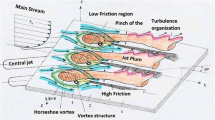Abstract
The effects of mainstream Reynolds number and turbulence to film cooling performance were investigated experimentally and computationally under rotating conditions in a 1.5-stage turbine. The rotor of the turbine included 18 blades with chord of 124.3 mm and height of 99 mm. A film hole was set in the middle span of the rotor blade surface with injection angles of 28° on the pressure side and 36° on the suction side respectively. The Reynolds number based on the mainstream velocity of the turbine outlet and the chord length of the rotor blade varied from 1.9 × 105 to 2.1 × 105. Measurements were made at three different rotation speeds of 702, 737 and 800 rpm to keep the rotating number consistent at 0.0280 while the blowing ratio varied from 0.5 to 2.0. Air and CO2 worked as coolant to achieve the density ratio of 1.03 and 1.57, respectively. Computational investigation was performed using the hexahedral structured grids and k-ε turbulence model. Results showed that the film coverage and cooling effectiveness are enlarged while the film deflection is weakened as the mainstream Reynolds number increases. Furthermore, the mainstream turbulence plays a negative role in the film coverage and cooling effectiveness at lower blowing ratio on both the pressure side and suction side while it promotes the film reattachment at higher blowing ratio on the suction side.












Similar content being viewed by others
Abbreviations
- C :
-
Chord length of the turbine blade (mm)
- D :
-
The diameter of the film hole (mm)
- DR :
-
Coolant-to-mainstream density ratio
- H :
-
Blade height (mm)
- L S :
-
The length of the film coverage in streamwise (mm)
- L H :
-
The length of the film coverage in spanwise (mm)
- M :
-
Blowing ratio, M = ρ c v c/ρ g v g
- Re g :
-
Reynolds number, Re g = ρ out v out C r/μ
- Rt :
-
Rotating number, Rt = ΩD/v g
- S :
-
Surface distance from the film hole (mm)
- T :
-
Temperature (K)
- Tu g :
-
Turbulence
- v :
-
Velocity (m/s)
- ρ :
-
Density (kg/m3)
- η :
-
Lateral-averaged adiabatic film cooling effectiveness, η = (T g − T aw)/(T g − T c)
- κ :
-
Gradient of the film trajectory centerline
- μ :
-
Dynamic viscosity of the mainstream (kg/m·s)
- Ω :
-
Rotating speed (rpm)
- aw:
-
Adiabatic
- c:
-
Coolant
- g:
-
Mainstream
- out:
-
Outlet of the turbine
- r:
-
Rotor blade
References
Han JC, Dutta S, Ekkad S (2001) Gas turbine heat transfer and cooling technology (chapter 3). Taylor & Francis, New York, pp 87–163
Suryanarayanan A, Mhetras SP, Schobeiri MT, Han JC (2009) Film-cooling effectiveness on a rotating blade platform. J Turbomach 13(1):011014-1-12
Takeishi K, Aoki S, Sato T, Tsukagoshi K (1992) Film cooling on a gas turbine rotor blade. J Turbomach 114:828–834
Tao Z, Li GQ, Deng HW, Xiao J, Xu GQ, Luo X (2011) Film cooling performance in a low speed 1.5-stage turbine: effects of blowing ratio and rotation. J Enhanc Heat Transf 18(5):419–432
Li GQ, Zhu JQ, Deng HW, Tao Z, Li HW (2013) Experimental investigation of rotating film cooling performance in a low speed 1.5-stage turbine. Int J Heat Mass Transf 61:18–27
Mehendale AB, Han JC (1993) Reynolds number effect on leading edge film effectiveness and heat transfer coefficient. Int J Heat Mass Transf 36(15):2723–2730
Li GQ, Deng HW (2011) Experimental investigation on film cooling performance of pressure side in annular cascades. J Therm Sci 20(2):119–126
Ou S, Rivir RB (2001) Leading edge film cooling heat transfer with high free stream turbulence using a transient liquid crystal image method. Int J Heat Fluid Flow 22:614–623
Choi JH, Teng SY, Han JC, Ladeinde F (2004) Effect of free-stream turbulence on turbine blade heat transfer and pressure coefficients in low Reynolds number flows. Int J Heat Mass Transf 47:3441–3452
Mayhew JE, Baughn JW, Byerley AR (2003) The effect of freestream turbulence on film cooling adiabatic effectiveness. Int J Heat Fluid Flow 24:669–679
Lebedev VP, Lemanov VV, Terekhov VI (2006) Film-cooling efficiency in a Laval Nozzle under conditions of high freestream turbulence. J Heat Transf 128:571–579
Funazaki K, Kawabata H, Takahashi D, Okita Y (2012) Experimental and numerical studies on leading edge film cooling performance: effects of hole exit shape and freestream turbulence. ASME Paper, No. GT2012-68217
Bons JP, MacArthur CD, Rivir RB (1994) The effect of high freestream turbulence on film cooling effectiveness. ASME Paper, No. 94-GT-51
Schmidt DL, Bogard DG (1996) Effects of free-stream turbulence and surface roughness on film cooling. ASME Paper, No. 96-GT-462
Hassan JS, Yavuzkurt S (2006) Comparison of four different two-equation models of turbulence in predicting film cooling performance. ASME Paper, No. GT2006-90860
Acknowledgments
This work was supported by the National Natural Science Foundation of China (Grant No. 51106156).
Author information
Authors and Affiliations
Corresponding author
Rights and permissions
About this article
Cite this article
Li, G., Zhu, J., Wang, K. et al. Film cooling performance in a low speed 1.5-stage turbine: effects of mainstream Reynolds number and turbulence. Heat Mass Transfer 51, 795–805 (2015). https://doi.org/10.1007/s00231-014-1446-6
Received:
Accepted:
Published:
Issue Date:
DOI: https://doi.org/10.1007/s00231-014-1446-6



